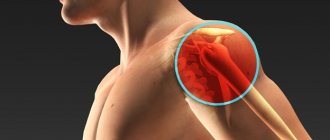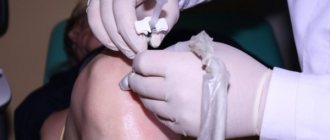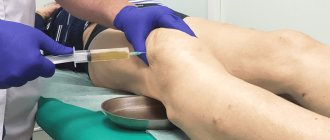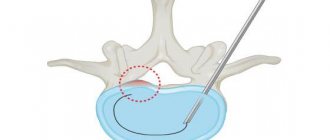The widespread use of injections based on hyaluronic acid into the joint began in 2014. Over the course of several years, experts were able to collect statistical data that confirm some and refute other known truths about these drugs. So, what is their effectiveness actually, based on the results of treatment of arthrosis and osteoarthritis of individual patients?
Hyaluronic acid injections are not a panacea
Criteria for assessing the effectiveness of drugs
Experts collected data regarding the effects of intra-articular injections on joints and analyzed it according to the following criteria:
- pain reduction;
- improving joint functioning;
- reduction of stiffness, including in the morning;
- reducing the intake of non-steroidal anti-inflammatory drugs.
Efficacy was assessed in three stages: after 2, 4 and 8 weeks.
Intra-articular injections of sodium hyaluronate, as it turned out, do not begin to act immediately
Efficiency of the procedure
Sodium hyaluronate is used, as a rule, in cases where corticosteroid drugs do not bring a visible effect and do not relieve the patient of pain. This procedure cannot be avoided when treating elderly people due to changes in the composition of the intra-articular fluid, which over time loses its nourishing and shock-absorbing functions. The cartilage becomes thinner and dries out, causing bone deformation.
In cases where the patient wants to do without surgery, and it is necessary to reduce pain as quickly as possible and at the same time avoid the use of anti-inflammatory drugs, hyaluronic acid is the only way out.
What they say a month after the start of the course of injections
Many patients note that during the first to third weeks after the start of injections, stiffness in the joint gradually decreased. If at the end of the first week 31% of respondents say this, then by the end of the third their number increases to 37%. After completing the treatment of arthrosis and osteoarthritis with this method, the effect persisted for 7-9 months.
As for the pain syndrome, a decrease in pain a month after the first injection was noted by 39% of patients, which is twice as much as in the previous case.
Drugs used
Substances that are used to treat arthritis and osteoarthritis are divided into several types:
- local anesthetics;
- chondroitin and glucosamine;
- steroid drugs;
- preparations containing sodium hyaloranate;
- specific medicinal substances, for example, platelet-rich plasma or ozonated solutions.
With the help of local anesthetics or painkillers, you can quickly achieve the effect of reducing pain and reducing sensitivity in the affected area, but it is worth keeping in mind that this will not be enough to treat joints.
To reduce swelling, glucocorticoids are used, the effect of their use lasts up to one month. These are the same corticosteroids that come in tablet form. When injected directly into the joint cavity, they are much more effective; in addition, this method avoids side effects such as dizziness and gastrointestinal problems.
Since these drugs are hormonal, it is recommended to use them no more than 3-5 times a year. For a disease such as infectious arthritis, the use of corticosteroid drugs is strictly prohibited. Instead, specialists use rinsing of the joint capsule and administer antibacterial drugs.
Drugs from the group of chondroprotectors help improve metabolic processes due to the human body producing its own collagen. This is a fibrillar protein that lies in the connective tissue of the body, the main building material for cartilage tissue and joints. A sufficient amount of it in the human body helps to cope with minor injuries on your own, without visiting a doctor.
The optimal solution for joint damage is the use of a so-called synovial prosthesis. A healthy human joint contains viscous and elastic synovial fluid; it protects the surface of the joints from chafing and protects against injury. Using intra-articular injections with hyaluronic acid, specialists managed to obtain the required consistency of injections, which will help not only relieve pain, but also restore damaged cartilage tissue.
The so-called PRP method, or injection of the patient’s blood plasma into the joint, is also often used. The plasma is first enriched with platelets. The advantage of this manipulation is that the patient cannot have allergic reactions to his own plasma, side effects are excluded.
Carboxytherapy is one of the new methods based on carbon dioxide injections. Its introduction into the joint accelerates blood circulation and metabolic processes. Its administration requires the use of special equipment, so this procedure is not so popular.
What happens after 8 weeks
About 35% of patients said they were almost completely free of pain during this period. Approximately 11% stopped taking anti-inflammatory drugs, and 40% reduced their dose by 20 times! Even those who continued to take this group of medications still reported noticeable relief in their joints.
In practice, Noltrex works longer and more effectively than sodium hyaluronate injections
Intra-articular injections of sodium hyaluronate into the knee are performed according to the following scheme:
Cons of injections
The main disadvantages of intra-articular injections include the difficulty of using them for small and deep-lying joints. In addition, they are contraindicated for children, as well as women during pregnancy and breastfeeding. Injections are prohibited in case of inflammatory processes, synovitis, hypersensitivity to the components of the drug, in the presence of obvious skin infections, abrasions and wounds.
| Introduction to the knee joint | Ankle injection |
Author of the article:
Litvinenko Andrey Sergeevich
Orthopedist
Make an appointment
Recent publications by the author:
- Chondroprotectors Piaskledin
- Chondroprotectors for osteochondrosis
- Fermatron Plus (Plus)
- Chondroprotectors Artra
What does this mean: conclusions
Research results indicate that injections of liquid prostheses based on hyaluronic acid have a delayed effect in relation to the treatment of osteoarthritis. Replenishment of the deficiency of synovial fluid occurs immediately, but the effect occurs only after a few weeks, and lasts relatively short time - 6-9 months. The maximum peak effect of sodium hyaluronate was recorded in the fourth week after the start of the course.
The synthetic drug "Noltrex" acts, according to doctors and patients, a little longer - from nine months to one and a half to two years. It contains no components that can be broken down by enzymes, so the medicine remains in the body much longer and has a powerful analgesic effect in a short time.
Of course, the effect of Noltrex on each patient is individual and depends on the stage of arthrosis, the characteristics of the disease and even the qualifications of the physician. However, in general, a synthetic-based drug, both in theory and in practice, is superior to sodium hyaluronate in terms of effectiveness.
Injections of hyaluronic acid into the joint
If you feel stiffness in your movements in the morning or severe pain in the joint, you should urgently see a doctor who will conduct an examination. Treatment in this case is necessary. At home, it is better not to experiment, but to immediately seek help from specialists.
It is important to understand that arthrosis cannot be completely cured, since the disease is irreversible. You can only slow down its development.
Hyaluronic acid injections are considered one of the most effective methods, and this has been repeatedly proven through many clinical studies.
How does this treatment affect the joints?
Hyaluronic acid is important for human organs because it is a component of them. Thanks to it, they are flexible, but at the same time quite durable. There is approximately 15 g of acid in our body, and, interestingly, every day one third of it is reconstructed.
In older people, the number of cells that can participate in the synthesis of hyaluronic acid often decreases. Due to its lack in the synovial fluid, tissue thinning occurs and wrinkles appear. This can lead to a number of diseases, for example, signs of deforming arthrosis of the joints will appear.
Hyaluronic acid acts as a conductor. Hyaline cartilage covers the articular surfaces of the joints; there are no blood vessels in this place; they are replaced by synovial fluid. Thus, it carries out all metabolic processes. The acid in the synovial fluid enters the middle of the cartilage, thereby reducing the friction force between other articular surfaces of the joint. This is what protects the joint from destruction and injury.
There is very little fluid in the joint, and with the development of various diseases, such as arthrosis, it can completely disappear from the cartilage cavity, in which case it is very easy to damage. The consequences can be different, for example, degenerative changes in the knee, severe pain or joint deformation. In this situation, it may lose its functions.
To prevent this from happening, the joint needs to be “nourished” using various methods. Injections directly into the joint are also called liquid prosthesis. Injecting hyaluronic acid into the knee will help increase its concentration in the joint, it will take on the functions of the lacking synovial fluid, promote the removal of unnecessary and toxic metabolic products, increase the mobility of the knee, and help eliminate pain in people suffering from arthrosis.
Why injections?
There are many different methods for providing acid to joints:
- ointments and gels;
- capsules or tablets;
- solutions for intra-articular injections.
Why is the latter method the most effective and popular among doctors?
Firstly, the medicine does not make its way through the digestive system, which is why most of it is destroyed, but immediately gets to the right place in maximum concentration.
Secondly, this method has been proven to be the most effective; the effect in other dosage forms has not been scientifically studied.
When is it better to start a course of treatment, the most effective period
Hyaluronic acid can be used at all stages. Of course, the greatest effect will be in the first and second stages of a disease such as knee arthrosis
, when the cartilage is not yet completely destroyed and there is something to restore. At the third stage of the disease, this is not effective, there will only be a short-term effect, because the cartilage tissue is no longer there and there is nothing to restore, in this case the patient can only be helped by surgical intervention, namely knee replacement.
Contraindications and side effects
It is prohibited to administer the medicine in the following cases:
- the patient is allergic to the drug;
- the integrity of the skin at the injection site is compromised;
- there is a rash;
- if there is an active inflammatory process;
- childhood and pregnancy;
- in case of acute infectious disease;
- if you have blood diseases;
- elevated temperature;
- the presence of a mental illness.
Injections with hyaluronic acid are usually easily accepted by the body, provided that the procedure is performed correctly. But sometimes complications and side effects appear:
- pain in soft tissues at the injection site due to damage from the needle;
- allergic reaction;
- feeling of itching, burning, swelling at the injection site;
- development of hemarthrosis due to bleeding.
Features of the use of solutions for intra-articular injections
Need to remember! All preparations with hyaluronic acid are quickly destroyed in the joint if there is an inflammatory process. Therefore, the injection is ineffective in case of exacerbation of arthrosis with signs of reactive synovitis. Injections should be given only in the remission stage of gonarthrosis.
From all of the above, we can conclude that it is impossible to quickly get rid of pain and inflammation in this way, but a course of injections will greatly improve the function of the joint, slow down the progression of arthrosis and reduce the number of possible pathologies, which will significantly alleviate the patient’s condition. It is important to understand that injections with hyaluronic acid work for the long term, and not for an immediate result.
Clinical studies have shown that the administration of the drug helps to delay the necessary surgery, and often avoid it.
If the injections are performed correctly, they are painless and are not accompanied by side effects, but you must follow all the doctor’s recommendations.
The course consists of 3-4 injections into each joint, the minimum interval between injections is 1-2 weeks.
You can repeat the course only after 1-1.5 years. Author: K.M.N., Academician of the Russian Academy of Medical Sciences M.A. Bobyr
Intra-articular injection: procedure
Safe intra-articular injections with sodium hyaluronate can only be performed by qualified medical specialists with the appropriate profile and skills. A doctor who knows the technique of performing such an injection most often has an orthopedic or surgical profile. Sometimes the procedure is entrusted to rheumatologists. If the actions are performed correctly, the medicine is guaranteed to get inside the joint: the structures of the articular tissue will be completely preserved.
Blockade of pain and deforming processes is carried out using a disposable sterile syringe after a thorough and comprehensive diagnosis. Many patients have their joint x-rayed first.
If necessary, the specialist will remove excess liquid, because... sometimes inflammatory exudate or blood may accumulate inside. All injections are performed with the finest needle. The duration of the event will take up to five minutes. To relieve the patient of unbearable pain and eliminate the inflammatory process, a short course of 1-3 procedures will be sufficient.
By contacting one of the best sanatoriums in Belarus - “Solnechny”, you can get a full range of high-quality treatment for arthritis and arthrosis. This is an effective blockade of degenerative joint changes through well-executed injections with hyaluronic acid, performed under sterile conditions by sanatorium specialists. Experienced doctors guarantee a minimum of pain and discomfort during the procedure.
Benefits of intra-articular injection
- When performing injections inside the joints, the maximum effect is achieved when it comes to treating large joints of the body. The injection method stands out from others for many reasons.
- A drug is delivered to the joint with a special needle, which receives the best conditions for absorption and preservation of its beneficial qualities in the body. One injection has a prolonged effect: the medicine is absorbed and acts throughout the year, providing a powerful therapeutic effect on the joint tissue.
- Injections are used to slow the progression of osteoarthritis. This allows you to postpone radical surgery or avoid replacing the affected joint with an artificial one at all.
- Injections are used to slow the progression of osteoarthritis. This allows you to postpone radical surgery or avoid replacing the affected joint with an artificial one at all.
- Hyaluronic acid therapy eliminates possible complications. If you use strong painkillers orally, you can disable the digestive system, and the use of intramuscular injections can be harmful to soft tissues and also not effective enough. Therefore, injections are considered a fast-acting option with minimal side effects.
- The procedure is also easily tolerated by the patient. The injections are performed by professionals who will minimize pain while performing this complex procedure quickly and accurately.









